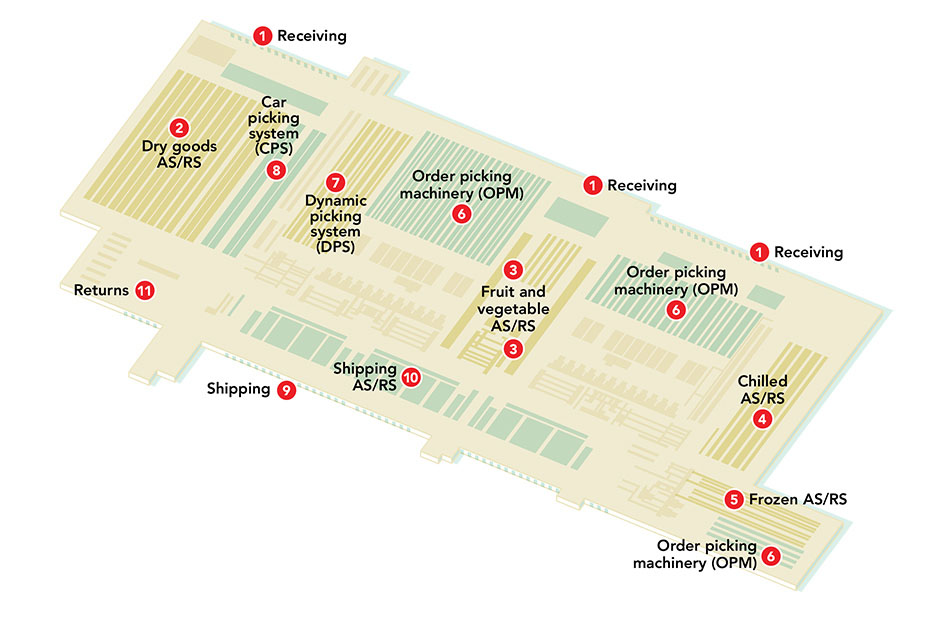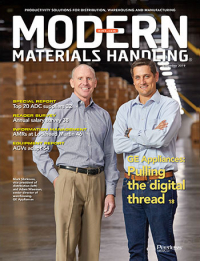Inside Coop’s Distribution Center: Bringing automation to grocery distribution
Coop’s highly automated distribution center handles more than 480,000 cases a day with pallet and case handling AS/RS and robotic palletizing.
Coop Logistics Center
Jessheim, Norway
Square Footage: 560,000 square feet, with a 355,200-square-foot expansion underway
Products Handled: Fresh, refrigerated and frozen groceries
SKUs: 17,000
Throughput: 480,000+ cases per day
People/Shifts: 3 shifts per day/6 days per week
Coop’s distribution center brings together pallet and case handling automated storage and retrieval technologies and robotic palletizing to fill orders for the local area as well as the cooperative’s network of DCs. Synchronization across work areas is critical, since totes and cases from one work area may be conveyed to and joined with pallets being produced in other work areas. As Ove Bjorgum, Coop’s director of logistics explains, “there is a lot of interleaving between systems.”
Receiving
Advance ship notifications, or ASNs, are sent for most goods. Incoming pallets are received (1) onto the central conveyor system and directed to one of several high-bay warehouses using automatic storage and retrieval system (AS/RS) technologies in temperature-controlled storage areas. These include pallet-handling AS/RS systems for ambient temperature for dry goods (2); refrigerated areas for fruits and vegetables stored at two different temperature levels (3); a chilled area for refrigerated products (4) and an area for frozen foods (5).
Picking
There are multiple picking systems in the facility, ranging from conventional voice-directed picking to fully automated case picking and palletizing. The system can build store-friendly pallets to streamline the putaway process in a store. Additionally, the system can build very densely packed pallets and tall pallets that maximize trailer loading and reduce transportation costs; and pallets with specific products on the bottom or top of pallets to comply with food safety requirements.
Order-Picking Machinery (OPM)
(6)
There are multiple OPM areas in the facility. Regardless of location, pallets retrieved from one of the AS/RSs are automatically depalletized. The cartons are then placed on storage trays and conveyed to a mini-load case handling system for temporary storage. When the product on a tray is needed for order fulfillment, it is automatically transferred to a smaller buffer mini-load system and then dispensed to a robotic palletizer, which builds optimal pallets. Slip sheets are placed between some layers to stabilize the pallets.
Dynamic Picking System (DPS)
(7)
Items that are too small or fragile for the automated picking systems are transported to the DPS area. There, product is removed from the cases in which it was received, placed in storage totes and stored in a mini-load system. To fill orders, totes are delivered to a dynamic pick face with picking stations. Order selectors are light directed as they transfer items from a donor tote to a shipping carton. Once all of the items for a carton have been picked, it is conveyed to the Order Picking Machinery, where it will be palletized along with cases from the OPM area.
Car Picking System (CPS)
(8)
This area is reserved for items that are too large or bulky for automated picking. Pallet pick locations in this area are automatically replenished by AS/RS cranes. Associates are voice-directed to a pick location and told how many items to pick to a pallet. Once all of the items for that pallet have been picked, the pallet is stretched wrapped and inducted onto the shipping conveyor. In a second picking process, items picked in the CPS area are used to top off a pallet of product picked from other areas.
Shipping
(9)
Once a pallet is ready for shipping, it is conveyed to one of four AS/RSs referred to as shipping buffers (10). Three of the buffers feature two cranes and 32 gravity conveyor lanes each and one buffer has one crane and 22 gravity conveyor lanes. Pallets are stored in a buffer AS/RS in shipping until they’re staged on gravity conveyor and loaded onto a truck.
Returns
(11)
The facility also includes an area for handling returns.

System suppliers
System Design, Integration, Implementation, Robotic Palletizer, Mini-Load AS/RS, Cranes, and Warehouse Management and Control System: Witron Integrated Logistics
Unit - Load AS/RS Cranes: Dambach Lagersysteme
Racking: Bito Storage Systems
Depalletizer: Riantics
Stretchwrapper: Strema
Voice-Directed Picking: Honeywell Voice (Vocollect)

Article Topics
Automation News & Resources
Walmart chooses Swisslog AS/RS and software for third milk processing facility Lucas Watson appointed CSO for Körber’s Parcel Logistics business in North America 60 Seconds with Bob Trebilcock, outgoing executive editor, Modern Materials Handling Kathleen Phelps to join FORTNA as chief financial officer Coles automates grocery distribution in Australia 2024 Intralogistics Robotics Survey: Robot demand surges Warehouse automation extends life of cheese DC by a decade More AutomationLatest in Materials Handling
Registration open for Pack Expo International 2024 Walmart chooses Swisslog AS/RS and software for third milk processing facility NetLogistik partners with Vuzix subsidiary Moviynt to offer mobility solutions for warehouses Materials Handling Robotics: The new world of heterogeneous robotic integration BSLBATT is looking for new distributors and resellers worldwide Lucas Watson appointed CSO for Körber’s Parcel Logistics business in North America Hyster recognizes Dealers of Distinction for 2023 More Materials HandlingAbout the Author
Subscribe to Materials Handling Magazine

Find out what the world's most innovative companies are doing to improve productivity in their plants and distribution centers.
Start your FREE subscription today.
April 2024 Modern Materials Handling

Latest Resources












